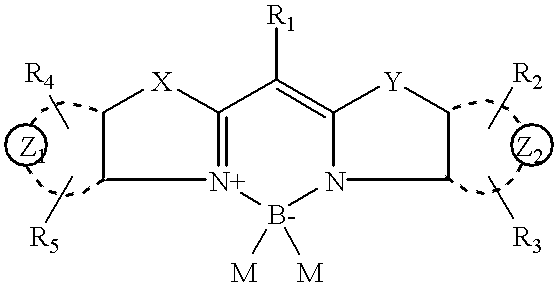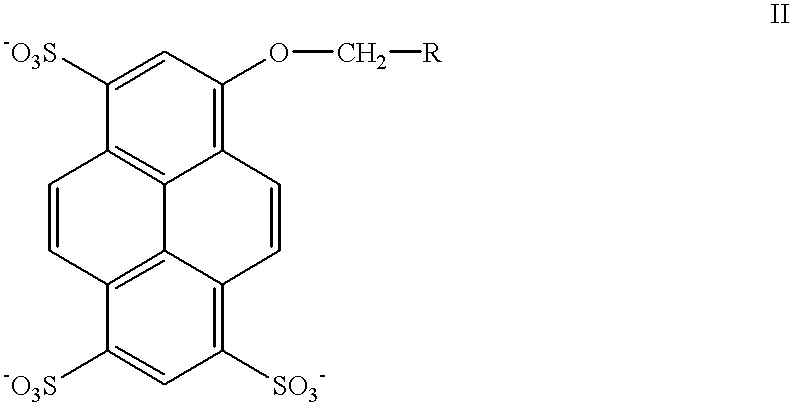Rigidized monomethine cyanines
a monomethine cyanine and cyanine technology, applied in the field of chemical dyes, can solve the problems of fluorescein dye precipitation, rare development of new fluorophores with optimal properties, and low detection efficiency of fluorescence emission, and achieve the effect of minimal background fluorescence and enhanced detection of fluorescence emission
- Summary
- Abstract
- Description
- Claims
- Application Information
AI Technical Summary
Benefits of technology
Problems solved by technology
Method used
Image
Examples
example b
Bis-benzoxazolylmethene borondifluoride
##STR37##
To produce the above compound, ortho aminophenol is condensed with malonic acid in polyphosphoric acid medium to produce bis (2-benzoxazolyl) methane in a 32% yield. See U.S. Pat. No. 3,250,780, the disclosure of which is incorporated herein by reference. An alternative to malonic acid in the condensation reaction is malonic acid diester. The condensate is then quaternized as in Example A and is subsequently condensed as in Example A above to form the boron-rigidized complex.
The observed absorption maxima, molar extinction coefficients, emission maxima and qualitative solubility data for the boron-rigidized complexes of Examples A and B are provided in Table 3.
TABLE 3 Spectral and Solubility Data for the Compounds of Examples A and B Bis-benzothiazolyl borondifluoride Bis-benzoxazolyl borondifluoride Logarithm Logarithm Max. of the Max. Max. of the Max. Solubility absorption Extinction emission absorption Extinction emission data* wave...
example c
Bis-carboxymethyl Benzoxazolylmethene Borondifluoride
The synthetic pathway for this compound is a eight-step procedure schematically represented as follows. ##STR38##
In a first step, carried out according to Humel in Synth. Commun. 15, pages 1081-88 (1985), to a magnetically stirred solution of 100 g (0.65 mole) of 4-hydroxyphenyl acetic acid in 250 ml of glacial acetic acid was added dropwise a mixture of 40 ml of nitric acid (1.4 specific gravity) and 60 ml glacial acetic acid. The glacial acetic acid was warmed to about 45.degree. C. to completely dissolve the 4-hydroxyphenyl acetic acid. Following addition of the nitric acid / acetic acid mixture, stirring of the resulting mixture was continued for one hour at 25.degree. C. and then the flask was chilled in ice water for one hour. The resulting crystals were washed with cold water and air-dried at room temperature, the reaction providing 65% of the theoretical yield of 3-nitro 4-hydroxyphenyl acetic acid.
In a second step, 19.7 g (...
example d
Chromophore 12
The synthetic pathway for producing this compound is schematically represented below. ##STR39##
In a first step, 2-cyanomethyl benzothiazole was prepared according to the method of Saito et al. (Synthesis, (3), pp. 210-11 (1983)). 2-amino benzenethiol (10 mmol) and malononitrile (10 mmol) were dissolved in 10 ml of ethanol with a small amount of glacial acetic acid (10 mmol) added. After stirring overnight, a yellow crystalline mass was recovered after filtration and drying, providing 80% of the theoretical yield of 2-cyanomethyl benzothiazole.
In a second step, a 1:1 molar ratio of 2-cyanomethyl benzothiazole and 2-aminophenol were uniformly mixed, ground and transferred to a round bottom flask. Polyphosphoric acid (approx. 80%, 20 ml for 10 mmol scale reaction) was warmed until fluid and then poured into the flask. The flask was then placed in a 185.degree. C. oil bath and heated in a nitrogen environment. After one hour, the flask was removed from the nitrogen environ...
PUM
| Property | Measurement | Unit |
|---|---|---|
| Molar density | aaaaa | aaaaa |
| Molar density | aaaaa | aaaaa |
| Molar density | aaaaa | aaaaa |
Abstract
Description
Claims
Application Information
 Login to View More
Login to View More - R&D
- Intellectual Property
- Life Sciences
- Materials
- Tech Scout
- Unparalleled Data Quality
- Higher Quality Content
- 60% Fewer Hallucinations
Browse by: Latest US Patents, China's latest patents, Technical Efficacy Thesaurus, Application Domain, Technology Topic, Popular Technical Reports.
© 2025 PatSnap. All rights reserved.Legal|Privacy policy|Modern Slavery Act Transparency Statement|Sitemap|About US| Contact US: help@patsnap.com



